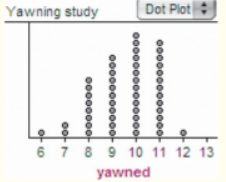Is yawning contagious?According to the popular TV show Mythbusters, the answer is “Yes.” In the March , episode, the Mythbusters team presented the results of an experiment involving subjects. All the subjects were placed in a booth for an extended period of time and monitored by hidden camera. Two-thirds of the subjects were given a “yawn seed” by one of the experimenters; that is, the experimenter yawned in the subject’s presence prior to leaving the room. The remaining subjects were given no yawn seed. What were the results? Of the subjects who had no yawn seed, 4 yawned. Of the 34 subjects given a yawn seed, 10 yawned. Adam Savage and Jamie Hyneman, the cohosts of Mythbusters, used these results to conclude that yawning is contagious.
(a) Explain how you could use slips of paper to randomly reassign the subjects to the treatment groups.
(b) Suppose we used your method in (a) to redo the random assignment 50 times. The Fathom dotplot displays the number of subjects in the yawn seed who yawned in each of these random assignments. What conclusion would you draw about whether yawning is contagious? Explain.





